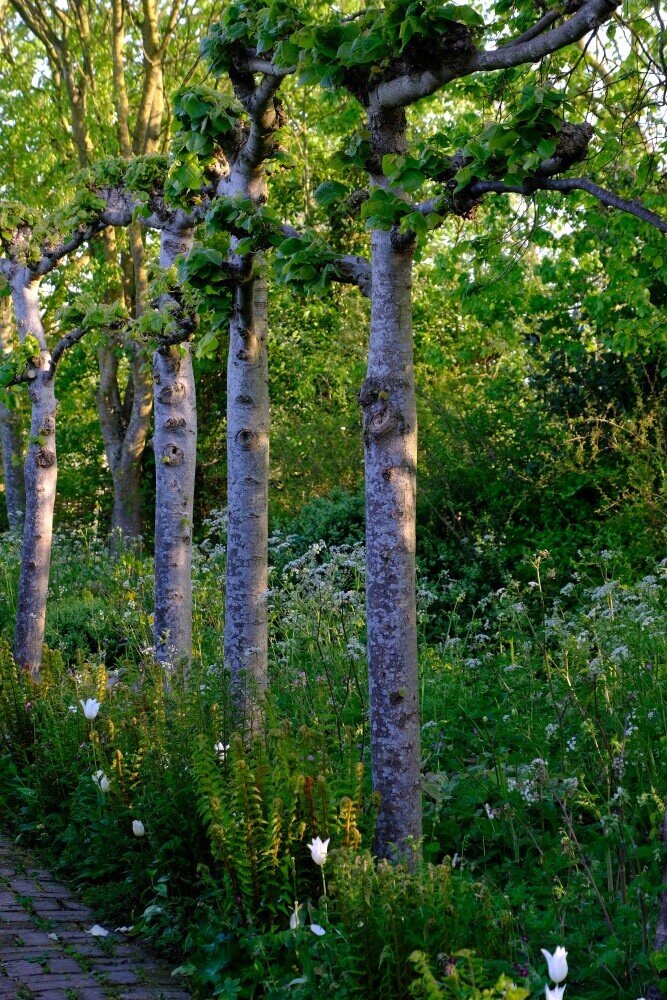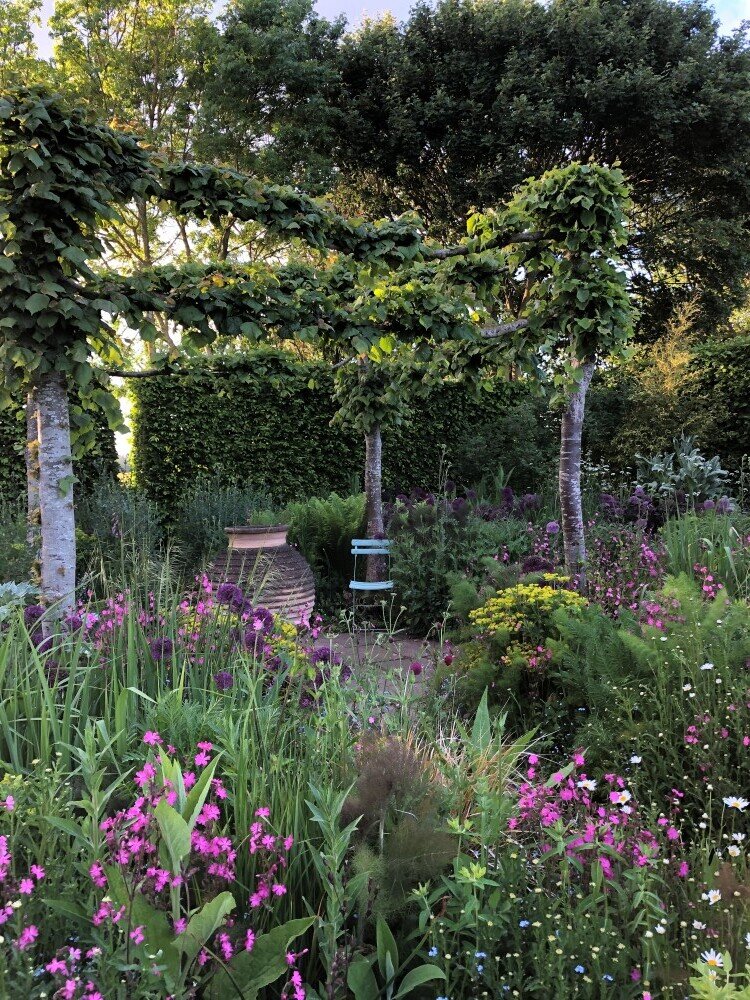May 2020
NIGEL
Nigel has died.
He was 12 and had a good life and his end was quick and painless and came after a very happy day when he walked and ate and played - gently - seemingly without a care. But it was a great shock and sadness.
He is now buried in the garden with many of his beloved tennis balls to accompany him on his journey.
His story is both ordinary - he was a beautiful dog that was a much loved member of our family - and completely extraordinary. Through his weekly appearances on ‘Gardeners' World’ he became known and loved by millions all over the world.
Wherever I went - boarding a plane in Missouri, going to Buckingham Palace, crossing the road in Tokyo, visiting a garden in Iran or filling the car with fuel in a provincial British town I would always be asked ‘Where’s Nigel’? and when I answered that he was at home there would be a look of profound disappointment.
Nigel had star quality. The camera adored him. I never had to tell him where to lie or walk because he instinctively knew exactly where and how to pose to capture the best light. He would spend every minute of a filming day with the crew, waiting patiently for his call and then happily repeating the same walk or actions again and again for the camera, getting right every time. He invariably stole every scene, every show.
When he was a guest on the ‘One Show’ he had his own limo stocked with tennis balls and the best dressing room with a choice of different coloured biscuits. He gave a talk at Hay literary festival to a sell out crowd - and loved it.
But above all he was our dear friend and now he is gone.
The Lockdown and severely restricted movement imposed as a result of Coronavirus has been tough for many people but the fact remains that for those of us with a garden there has been a silver lining. Throughout April I suspect that more of us spent more time at home than at any time since we were small children and here at home the weather throughout April was a joy.
It was probably the best Spring I can remember with day after day of sunny, warm weather and the blossom, tulips and early spring flowers performed like never before. This provided a really important physical and mental solace for many people and for others who had seen their gardens as little more than an outdoor appendage to the house found themselves having the time and inclination to start to grow something and to relish the fruits of this labour.
It looks like the restrictions will stay in place in some form throughout the rest of May so it is a time to make the most of what we have and to be thankful that May is the most exciting and beautiful of all months in the garden.
May begins in Spring and ends in Summer with the garden unfolding like a paper flower in water. The days lengthen out luxuriously and by the end of the month I could start gardening outside at five and continue till ten at night all in full daylight. With this extra light - and hopefully heat - the flower borders cease to limber up and put on a full, passionate performance. Peonies, irises, roses, poppies, alliums and delphiniums rise to their astounding glory.
The vegetable garden is providing asparagus, lettuce, rocket, spring cabbages, early broad beans, chard, spinach, radish and the last of the purple sprouting broccoli. All our tender plants can be planted out and freed from the protective restraint of winter.
Yet, despite the sense of a garden rising to its crescendo there is always the sense of more to come, of growth and expansion and a soaring hope driving through every living cell.
And never have we needed or appreciated that more than now.
What to do in the garden this month:
SOW FRENCH BEANS
If your soil has warmed up - and only feeling it with your skin will determine that - then you can safely sow a batch of French beans, both dwarf and climbing. These are tender plants that will be knocked right back by a touch of frost and will survive but not grow if the temperature drops below about 10 degrees and then become fair game for slugs and snails. But by the time they have germinated we will be clear of those cold temperatures in most areas and the young plants can grow strongly.
Sow dwarf beans in rows in well manured soil with each bean spaced 6 inches apart and the rows 12-18 inches apart. For climbing beans sow two seeds at the base of each support and remove the weaker of the two once one is established and growing strongly. Water them well and keep them watered throughout the growing season.
THE CHELSEA CHOP
The ‘Chelsea Chop’ refers to cutting back some of the growth of late-flowering perennials by about a third to delay flowering and increase the number of side shoots which will result in more - if slightly smaller - blooms and staggers their display later in summer.
CUT BACK ALLIUM LEAVES
Unlike most bulbs, the foliage of alliums can be cut back immediately after flowering. In a border this will create space for planting tender annuals such as cosmos, zinnias, tithonia or sunflowers.
LILY BEETLE
Check the leaves of lilies and fritillaries for lily beetle. These have a bright red casing on their upper side but are brown on the underside so although very visible when nibbling the leaves - which they do voraciously - they will drop off if they sense trouble and lie on their backs on the ground so are completely camouflaged. There is no known predator so the only control is to pick them off by hand and dispose of them.
DIVIDE AND MOVE GRASSES
Unlike herbaceous perennials, grasses are best divided once they have started to grow vigorously. Lift the clump and divide into fairly substantial sections - they grow slowly so do not cut them up into too small pieces. Replant them at the same level they were in before and water in well. Keep watering them weekly until they are growing strongly.
Some grasses seed themselves freely and form crowded clumps and these can be thinned and moved by lifting entire young plants and repositioning with more space around them.
STAKE AND SUPPORT HERBACEOUS PERENNIALS
Any plant that has been knocked or collapsed never looks the same, however carefully you prop it up, so the secret is to support plants before they need supporting. If you place supports in position whilst the plants are still relatively short they will quickly be hidden by the new growth and as a result your borders will not look corseted and constrained. It does not matter what you use - I prefer home made metal supports that are rusted and almost invisible after a day or two but stakes and twine or twiggy prunings all work well.
DIVIDE AQUATIC PLANTS
By the middle of May the water of any pond is likely to be warm enough to plant into and to lift and divide any existing plants as well as plant deep water aquatics like water lilies.
DEADHEAD TULIPS
If you have tulips growing in borders, deadhead them once they are past their best. This will stop the development of seed so that all the energy goes into forming new bulbs for next year’s flowers. The best way to deadhead them is simply to snap off the spent flower with the growing seed pod using your fingers.
Do not cut back the stem or any of the foliage as this will all contribute to the growing bulbs as they slowly die back.
TOMATOES
It is time to plant out tomatoes if you have not already done so, burying them deeply - right up to the bottom leaf as the buried section of stem will develop extra roots.
As the young plants grow they form shoots between the leaves and the stem and these are known as side-shoots. They grow with extra vigour and although they do bear trusses of fruit, they take energy from the plant and reduce the overall harvest as well as making a cordon plant straggly. So they should be removed as they appear.
The best way to do this is in the morning when the plant is turgid, simply breaking them off with finger and thumb. However in the evening they will be limper and may tear the plant so should be cut off with a knife.
PLANTING TENDER ANNUALS
By the middle of May tender annuals like sunflowers, Zinnias, Cosmos or Tobacco plants can be planted out into all but the coldest gardens, especially if you have hardened them off for at least a week. Hardening off is important and will mean much faster growing and longer-lasting flowers - so if you buy any of these annuals from a garden centre over the coming weeks, do not plant them out immediately but put them in a sheltered place for a week to acclimatise to your garden, as they will probably have been kept sheltered for the best retail display.
I like to use tender annuals both in containers and borders and in the latter I do not use them as bedding but to enrich the general tapestry of the overall planting. So I place them in groups so they make drifts and clumps rather than straight lines.
Space them about 12 - 18 inches apart in a sunny situation that is sheltered from strong winds and water them in well. As long as the temperature does not drop below 5 degrees they should grow strongly and flower well into autumn.
PRUNE EARLY FLOWERING CLEMATIS
The best time to prune early-flowering clematis such as c. montana, armandii, alpina and macropetala, is immediately after they finish flowering. Obviously the timing of this will vary considerably in different parts of the country but the principal remains constant and for many of us this occurs at the end of May.
Next year’s flowers are formed on all the new growth made from this period until late summer so if you prune them much later than mid to late June you will be removing potential flowers that would bloom next spring.
Pruning of these clematis is solely to maintain their size and spread for your convenience rather than for any horticultural benefit. So cut back freely, not worrying about individual stems or the position of the cut. Then when you have finished, weed round the plant, water it well and mulch generously with garden compost or bark chippings.
MAKE COMPOST
Compost is the alchemy of a garden, turning waste into black gold and we should compost every scrap of garden and kitchen waste. The secret of making it reasonable quickly is to have a good mix of matter high in nitrogen (green) like grass clippings and drier material (brown) that is high in carbon and then to aerate it often by turning it. This does not have to be a major operation - just forking through it will help a lot. The point is to get oxygen into the heap which in turn feeds the bacteria that eat the decomposing material and convert it into compost which will then enrich your soil with essential bacteria, fungi and nutrients better than any product known to man.




























































